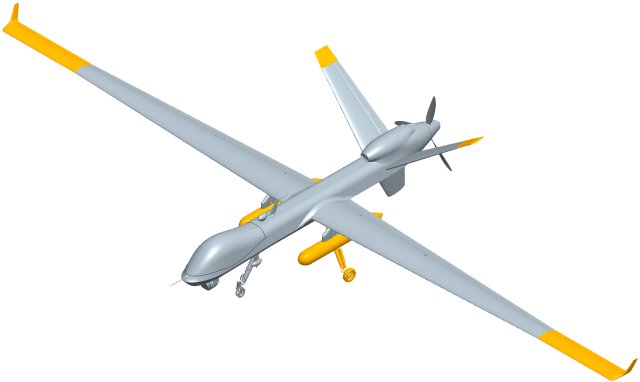 The U.S. Air Force wants to purchase an extended-range (ER) version of the MQ-9 Reaper, allowing the service to strike deeper into enemy territory using fewer aircraft in a post-Afghanistan environment.
The U.S. Air Force wants to purchase an extended-range (ER) version of the MQ-9 Reaper, allowing the service to strike deeper into enemy territory using fewer aircraft in a post-Afghanistan environment.
“They’ve approved it; it’s a matter of details now,” Chris Pehrson, Director for Strategic Development with Reaper builder General Atomics, told Defense News. “The programme is going to go forward.”
Although the service will not comment on future budget submissions, with one spokesman calling it “premature,” a senior Defense Department source said the programme will be one of the few new starts in the 2014 budget request due to Congress this month.
The President’s financial request is likely dead on arrival, with the budget expected to be nearly $55 billion over the post-sequestration funding.
But the fact the enhanced Reaper is expected in the budget at all, given the cuts the Pentagon has attempted to make, speaks to how important the Air Force views the program.
The use of UAS in Afghanistan has increased significantly over the past year as the Obama administration prepared for troops to leave the country, and that trend seems likely to continue. The ER model could allow incursions into Pakistan despite the loss of the Afghan bases that have been home to many unmanned launches in the past decade.
The UAS’ range would be extended using a modification kit that will replace the wings on older Reaper models with a newer design equipped with fuel tanks.
The modification would extend the operational capability of the Reaper by about 10 hours. The standard Reaper is configured for 30 hours for the ISR model, and roughly 23 hours if armed with Hellfire missiles. General Atomics believes the ER model would up those to 42 hours for ISR and 35 hours with the Hellfire.
Pehrson said the company plans to meet with Air Force officials this Friday to iron out some of the details, but declined to comment on whether the company was expecting its new design to be in the 2014 budget.
Air Force officials have been intrigued by the potential of increased-range UAS, not just for the tactical potential, but also as a cost-saving measure that could drive down the number of Reapers needed worldwide.
“Extended range would give you certain capabilities to perform certain missions which would be very advantageous, and it would allow the Air Force to look for certain efficiencies,” said Colonel Bill Tart, director of the Air Force’s Remotely Piloted Aircraft Capabilities Division, in a recent interview. “Everyone has been working toward a normalized CAP [combat air patrol]. You have roughly between two and three per CAP, fleetwide right now. And if you got an extended-range capability, you might be able to cut that down because your airplanes can stay aloft longer.”
“We are, of course, looking at what the right range of capabilities, including range and endurance, as well as numbers and future requirements, should be for the Reaper and ISR in general,” said Todd Vician, a spokesman for Air Combat Command. “However, it’s premature to provide details of ongoing discussions.”
When asked whether the extended-range Reaper was included in the 2014 budget, Vician said, “I can’t confirm [2014] 14 POM plans until the budget proposal is released.”Extra Range for New Missions
“As we draw down in Afghanistan, as we left Iraq, our basic range has become an issue,” Pehrson said. The pivot to the Pacific, as well as a renewed focus in Africa, require UAS that can travel longer distances, he said.
General Atomics began looking into an ER model 18 months ago, Pehrson said, and developed a number of potential designs.
That included two test models for NASA that featured an 80-foot wingspan. While the model successfully increased both the endurance and altitude of the UAS, the Air Force rejected it because of concerns with its size; increasing the wings by that much would require redesigning the infrastructure, such as hangars and shipping containers, which are already in use.Test models included versions with longer wings, but the Air Force selected a different fix: new wings, the same size as the traditional Reaper design, that come equipped with extra fuel tanks and winglets to help reduce drag. The fuel tanks are detachable, leaving the wing stations free to carry other payloads, such as sensors or weapons, but they are not drop tanks that can be jettisoned in flight.
The modifications are backward-compatible to the traditional MQ-9 fuselage, so teams in the field could strip off the wings and attach the new ones relatively easily.
Pehrson puts the cost per unit in the ballpark of $500,000 to $1 million, although he noted those are rough figures that could change.
“There’s no contract yet,” Pehrson said. “We’ve done some budgetary estimates, we’ve given them prices and they haven’t balked at that. They’re agreeing those are reasonable numbers.”
He also said the kits could be in the field 18 months after a contract is signed, in limited quantities.
The long-term plan would be for General Atomics to replace the older wing design in its production facility so new Reapers would come with the new wings installed. The Air Force has received less than half of the roughly 400 Reapers it has ordered, “so whenever they cut into production the remainders would be [extended-range],” Pehrson said.
Source: Defense News
